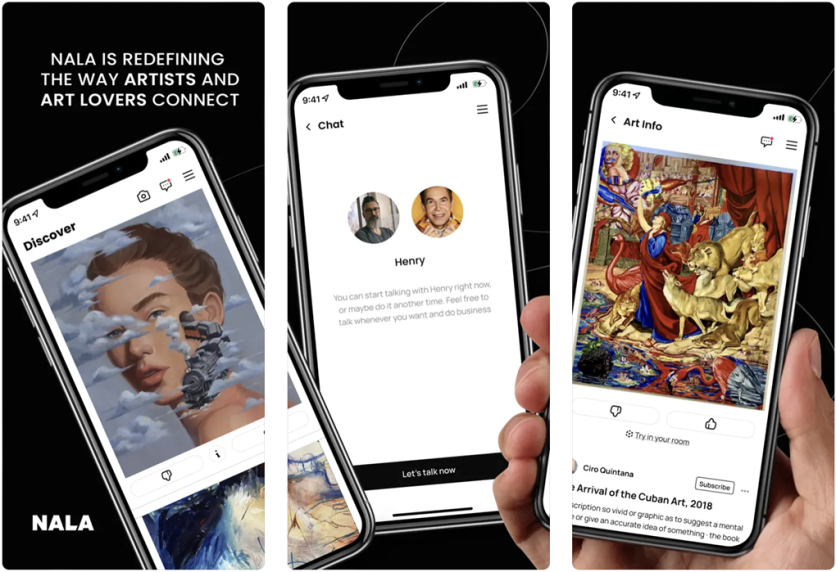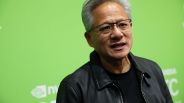"The term AI has become a catchall for all things algorithm-related lately, but many of these algorithms are quite old, dating back to the 1950s with Alan Turing, the problem was that computers weren't advanced enough and there wasn't enough data to implement the ideas," says Ben Gulak. Networked Artistic Learning Algorithm (NALA) uses what's called Recommender Engine Algorithms, which look for patterns in data to make personalized suggestions to users, showing them content they'll likely enjoy.
This is very different from the popular term Generative AI, which has recently been taking the world by storm with platforms like ChatGPT and Midjourney, which often receive negative reactions for their potential to replace human creativity.
AI, like any new technology, has the potential for both good and evil; the important aspect is how it is used. NALA uses AI to put fine artists at the front and center of their company, enabling them to reach their full commercial potential while simultaneously banning any generative AI art from being listed.
Through this rise of Generative AI, all industries are being disrupted, from healthcare to customer service and finance. Generative AI has undoubtedly started a new era where machines enhance human potential at astounding scales. Some argue that it promises increased efficiency and novel innovations. On the other hand, others worry that AI might outpace human capabilities if unchecked.
Most fail to realize that a middle ground could exist—a nuanced perspective that recognizes AI as a tool to amplify human potential and not a replacement for it. This is in part due to the nature in which Generative AI functions. This balanced approach is critical in the art world, where AI's influence is profound. AI is indeed impacting sectors that rely on quantifiable data and precise calculations, but it's also entering creative fields. It challenges the traditional methods of artistic creation and sparks fierce debate.
Supporters embrace AI as a new medium of creative expression and view it as a means to exceed the limits, generate ideas, and democratize art creation. Meanwhile, detractors fear it devalues the human touch and threatens the livelihoods of artists who've spent years improving their craft. Both perspectives pose a question: Is AI's role in art a complementary tool or an existential threat?
This debate mirrors a historical moment when photography was introduced in the 19th century. In 1839, French painter and physicist Louis Daguerre changed the art landscape with his invention, the Daguerreotype. With it, reality can be captured in a way painters can't. Some artists welcomed photography as a tool that helped them in their creative process, as it provided them with a method to study light and composition.
Critics argued that photography is an imitation of "true art." They believed its mechanical nature drains the art of its soul. The art community eventually acknowledged that photography didn't replace painting. It even prompted new artistic movements, such as Impressionism. Impressionism embraces aspects of fleeting light, color, and motion—something photography couldn't capture.
This movement established that photography isn't a competitor but a complement to painting. In the same way, AI can be viewed as today's photography, expanding the concept of visual expression. Ben Gulak, an MIT-educated computer scientist and painter, believes AI could help artists explore new dimensions.
Ben is known for combining his background and expertise in the art and tech fields to bring fresh perspectives to the industry. He has been recognized with numerous awards for his innovations, from environmentally-friendly transportation projects to extreme sports. The modern Renaissance man has also earned a reputation for having his works grace prominent galleries. Ben's exploration of both worlds allowed him to create NALA, a pioneering digital platform for art discovery and collecting.

NALA is a true example of how computer science can be used as a medium of good within the industry by facilitating engaging and meaningful connections between artists and collectors. In the case of NALA, the AI is being used to make highly personalized recommendations for art lovers, showing them artwork that they would never have seen before. Thus, the roadblocks that prevent many artists from entering the global market or being discovered are eliminated. Similarly, it declutters the market so art lovers can be exposed to unique pieces that align with their tastes, and, at the same time, the platform expands their horizons to new styles and genres. Overall, NALA leverages data science to create an inclusive art world.
Ben realized that the real risk with AI isn't its existence but the vast inequalities created by access to data and the required computing power. "Many overlook this element in the AI conversation, and it's concerning," he says. "Tech giants control almost all the data (Meta, Google, Microsoft or Amazon, etc.). This means smaller players are at a disadvantage. They're restricted by their inability to build their own datasets and not having the computing power to run their models, it's almost impossible to develop your own AI systems without using either Google or Amazon's cloud computing, and collecting the data is still a problem." Ben states that this "data divide" prevents many from entering the field of AI which stifles innovation enabling an elite few to shape the future of how AI integrates into our lives. "With a tool as powerful as AI, everybody should have access to its potential to innovate, not simply interacting with chatbots as is currently the case. We the people are sharing all of our private personal data with the tech giants to in turn build their AI models for what? So that we get better customer service bots," Ben says.
The discourse surrounding AI will continue to unfold. Technological progress will inevitably touch every aspect of society. Ben Gulak represents a balanced approach, advocating for an artistic landscape where AI complements human creativity and champions innovation while preserving the integrity of art. He reminds artists to embrace their irreplaceable ability to interpret, imagine, and inspire while deeming AI as a valuable ally that they can shape to integrate into their work.
ⓒ 2025 TECHTIMES.com All rights reserved. Do not reproduce without permission.





